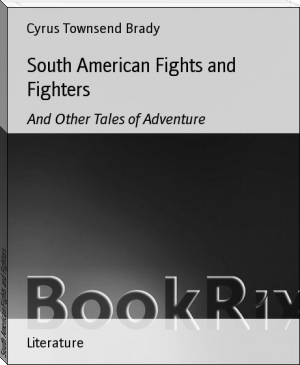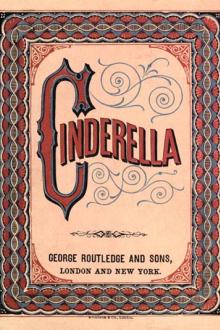South American Fights and Fighters, and Other Tales of Adventure by Brady (rosie project .txt) 📕

Read free book «South American Fights and Fighters, and Other Tales of Adventure by Brady (rosie project .txt) 📕» - read online or download for free at americanlibrarybooks.com
- Author: Brady
Read book online «South American Fights and Fighters, and Other Tales of Adventure by Brady (rosie project .txt) 📕». Author - Brady
E-text prepared by Al Haines
"The Poor Little Governor . . . Distanced His Fierce Pursuers at Last"
AMERICAN FIGHTS AND FIGHTERS SERIES
South American Fights and Fighters AND OTHER TALES OF ADVENTURE
BY CYRUS TOWNSEND BRADY, LL. D.
ILLUSTRATIONS BY
SEYMOUR M. STONE, GEORGE GIBBS, W. J. AYLWARD
AND J. N. MARCHAND
TOGETHER WITH REPRODUCTIONS FROM
OLD PRINTS AND PORTRAITS
GARDEN CITY ———— NEW YORK
DOUBLEDAY, PAGE & COMPANY
MCMXIII
ALL RIGHTS RESERVED, INCLUDING THAT OF TRANSLATION
INTO FOREIGN LANGUAGES, INCLUDING THE SCANDINAVIAN
COPYRIGHT, 1910, BY DOUBLEDAY, PAGE & COMPANY
PUBLISHED, APRIL, 1910
To
George William Beatty
Good Fellow, Good Citizen
Good Friend
PREFACE
The first part of this new volume of the American Fights and Fighters Series needs no special introduction. Partly to make this the same size as the other books, but more particularly because I especially desired to give a permanent place to some of the most dramatic and interesting episodes in our history—especially as most of them related to the Pacific and the Far West—the series of papers in part second was included.
"The Yarn of the Essex, Whaler" is abridged from a quaint account written by the Mate and published in an old volume which is long since out of print and very scarce. The papers on the Tonquin, John Paul Jones, and "The Great American Duellists" speak for themselves. The account of the battle of the Pitt River has never been published in book form heretofore. The last paper "On Being a Boy Out West" I inserted because I enjoy it myself, and because I have found that others young and old who have read it generally like it also.
Thanks are due and are hereby extended to the following magazines for permission to republish various articles which originally appeared in their pages: Harper's, Munseys, The Cosmopolitan, Sunset and The New Era.
I project another volume of the Series supplementing the two Indian volumes immediately preceding this one, but the information is hard to get, and the work amid many other demands upon my time, proceeds slowly.
CYRUS TOWNSEND BRADY.
ST. GEORGE'S RECTORY,
Kansas City, Mo., February, 1910.
CONTENTS
PART I
SOUTH AMERICAN FIGHTS AND FIGHTERS PAGE PANAMA AND THE KNIGHTS-ERRANT OF COLONIZATION I. THE SPANISH MAIN 3 II. THE DON QUIXOTE OF DISCOVERERS AND HIS RIVAL 5 III. THE ADVENTURES OF OJEDA 10 IV. ENTER ONE VASCO NU�EZ DE BALBOA 17 V. THE DESPERATE STRAITS OF NICUESA 20
PANAMA, BALBOA AND A FORGOTTEN ROMANCE I. THE COMING OF THE DEVASTATOR 31 II. THE GREATEST EXPLOIT SINCE COLUMBUS'S VOYAGE 34 III. "FUROR DOMINI" 42 IV. THE END OF BALBOA 44
PERU AND THE PIZARROS I. THE CHIEF SCION OF A FAMOUS FAMILY 53 II. THE TERRIBLE PERSISTENCE OF PIZARRO 57 III. "A COMMUNISTIC DESPOTISM" 68 IV. THE TREACHEROUS AND BLOODY MASSACRE OF CAXAMARCA 73 V. THE RANSOM AND MURDER OF THE INCA 85 VI. THE INCA AND THE PERUVIANS STRIKE VAINLY FOR FREEDOM 93 VII. "THE MEN OF CHILI" AND THE CIVIL WARS 102 VIII. THE MEAN END OF THE GREAT CONQUISTADOR 105 IX. THE LAST OF THE BRETHREN 108
THE GREATEST ADVENTURE IN HISTORY I. THE CHIEF OF ALL THE SOLDIERS OF FORTUNE 115 II. THE EXPEDITION TO MEXICO 120 III. THE RELIGION OF THE AZTECS 125 IV. THE MARCH TO TENOCHTITLAN 130 V. THE REPUBLIC OF TLASCALA 138 VI. CORTES'S DESCRIPTION OF MEXICO 147 VII. THE MEETING WITH MONTEZUMA 162 VIII. THE SEIZURE OF THE EMPEROR 171 IX. THE REVOLT OF THE CAPITAL 174 X. IN GOD'S WAY 177 XI. THE MELANCHOLY NIGHT 182 XII. THE SIEGE AND DESTRUCTION OF MEXICO 194 XIII. A DAY OF DESPERATE FIGHTING 198 XIV. THE LAST MEXICAN 215 XV. THE END OF CORTES 218
PART II
OTHER TALES OF ADVENTURE THE YARN OF THE "ESSEX," WHALER 231
SOME FAMOUS AMERICAN DUELS 245 I. A TRAGEDY OF OLD NEW YORK 246 II. ANDREW JACKSON AS A DUELLIST 248 III. THE KILLING OF STEPHEN DECATUR 251 IV. AN EPISODE IN THE LIFE OF JAMES BOWIE 252 V. A FAMOUS CONGRESSIONAL DUEL 254 VI. THE LAST NOTABLE DUEL IN AMERICA 256
THE CRUISE OF THE "TONQUIN" 261
JOHN PAUL JONES 281 I. THE BIRTH OF THE AMERICAN NAVY 283 II. JONES FIRST HOISTS THE STARS AND STRIPES 284 III. THE BATTLE WITH THE "SERAPIS" 285 IV. A HERO'S FAMOUS SAYINGS 287 V. WHAT JONES DID FOR HIS COUNTRY 288 VI. WHY DID HE TAKE THE NAME OF JONES 289 VII. A SEARCH FOR HISTORICAL EVIDENCE 292 VIII. THE JONESES OF NORTH CAROLINA 296 IX. PAUL JONES NEVER A MAN OF WEALTH 297
IN THE CAVERNS OF THE PITT 301
BEING A BOY OUT WEST 315
INDEX 335
LIST OF ILLUSTRATIONS
"THE POOR LITTLE GOVERNOR … DISTANCED HIS FIERCE
PURSUERS AT LAST"
Drawing by Seymour M. Stone Frontispiece FACING PAGE "OJEDA GALLOPED OFF WITH HIS … CAPTIVE"
Drawing by Seymour M. Stone 6 "THE INDIANS POURED A RAIN OF POISONED ARROWS"
Drawing by Seymour M. Stone 7 "BALBOA … ENGAGED IN SUPERINTENDING THE ROOFING OF A HOUSE"
Drawing by George Gibbs 34 "THE EXPEDITION HAD TO FIGHT ITS WAY THROUGH TRIBES OF WARLIKE AND FEROCIOUS MOUNTAINEERS"
Drawing by George Gibbs 35 "HE TOOK POSSESSION OF THE SEA IN THE NAME OF CASTILE AND LEON"
Drawing by George Gibbs 40 "HE THREW THE SACRED VOLUME TO THE GROUND IN A VIOLENT RAGE"
Drawing by George Gibbs 41 "THEY BURST UPON THE RANKS OF THE UNARMED INDIANS"
Drawing by George Gibbs 86 "THE THREE PIZARROS … SALLIED OUT TO MEET THEM"
Drawing by George Gibbs 87 "HE THREW HIS SOLE REMAINING WEAPON IN THE FACES OF THE ESCALADERS"
Drawing by George Gibbs 102 FERNANDO CORTES
From a picture in the Florence Gallery 103 THE DEATH OF MONTEZUMA
From an old engraving 178 "HE DEFENDED HIMSELF WITH HIS TERRIBLE SPEAR"
Drawing by George Gibbs 179 "THE SHIP CAME TO A DEAD STOP"
Drawing by W. J. Aylward 234 THE KILLING OF ALEXANDER HAMILTON BY AARON BURR
Drawing by J. N. Marchand 233
The publishers wish to acknowledge their indebtedness to The Cosmopolitan Magazine and Munsey's Magazine for permission to use several of the illustrations in this volume.
{3} PART I
SOUTH AMERICAN FIGHTS AND FIGHTERS
I Panama and the Knights-Errant of Colonization I. The Spanish Main
One of the commonly misunderstood phrases in the language is "the Spanish Main." To the ordinary individual it suggests the Caribbean Sea. Although Shakespeare in "Othello," makes one of the gentlemen of Cyprus say that he "cannot 'twixt heaven and main descry a sail," and, therefore, with other poets, gives warrant to the application of the word to the ocean, "main" really refers to the other element. The Spanish Main was that portion of South American territory distinguished from Cuba, Hispaniola and the other islands, because it was on the main land.
When the Gulf of Mexico and the Caribbean Sea were a Spanish lake, the whole circle of territory, bordering thereon was the Spanish Main, but of late the title has been restricted to Central and South America. The buccaneers are those who made it famous. So the word brings up white-hot stories of battle, murder and sudden death.
The history of the Spanish Main begins in 1509, with the voyages of Ojeda and Nicuesa, which were the first definite and authorized attempts to colonize the mainland of South America.
The honor of being the first of the fifteenth-century {4} navigators to set foot upon either of the two American continents, indisputably belongs to John Cabot, on June 24, 1497. Who was next to make a continental landfall, and in the more southerly latitudes, is a question which lies between Columbus and Amerigo Vespucci.
Fiske, in a very convincing argument awards the honor to Vespucci, whose first voyage (May 1497 to October 1498) carried him from the north coast of Honduras along the Gulf coast around Florida, and possibly as far north as the Chesapeake Bay, and to the Bahamas on his return.
Markham scouts this claim. Winsor neither agrees nor dissents. His verdict in the case is a Scottish one, "Not proven." Who shall decide when the doctors disagree? Let every one choose for himself. As for me, I am inclined to agree with Fiske.
If it were not Vespucci, it certainly was Columbus on his third voyage (1498-1500). On this voyage, the chief of the navigators struck the South American shore off the mouth of the Orinoco and sailed westward along it for a short distance before turning to the northward. There he found so many pearls that he called it the "Pearl Coast." It is interesting to note that, however the question may be decided, all the honors go to Italy. Columbus was a Genoese. Cabot, although born in Genoa, had lived many years in Venice and had been made a citizen there; while Vespucci was a Florentine.
The first important expedition along the northern coast of South America was that of Ojeda in 1499-1500, in company with Juan de la Cosa, next to Columbus the most expert navigator and pilot of the age, and Vespucci, perhaps his equal in nautical science as he {5} was his superior in other departments of polite learning. There were several other explorations of the Gulf coast, and its continuations on every side, during the same year, by one of the Pizons, who had accompanied Columbus on his first voyage; by Lepe; by Cabral, a Portuguese, and by Bastidas and La Cosa, who went for the first time as far to the westward as Porto Rico on the Isthmus of Darien.
On the fourth and last voyage of Columbus, he reached Honduras and thence sailed eastward and southward to the Gulf of Darien, having not the least idea that the shore line which he called Veragua was in fact the border of the famous Isthmus of Panama. There were a number of other voyages, including a further exploration by La Cosa and Vespucci, and a second by Ojeda in which an abortive attempt was made to found a colony; but most of the voyages were mere trading expeditions, slave-hunting enterprises or searches, generally fruitless, for gold and pearls. Ojeda reported after one of these voyages that the English were on the coast. Who these English were is unknown. The news, however, was sufficiently disquieting to Ferdinand, the Catholic—and also the Crafty!—who now ruled alone in Spain, and





Comments (0)